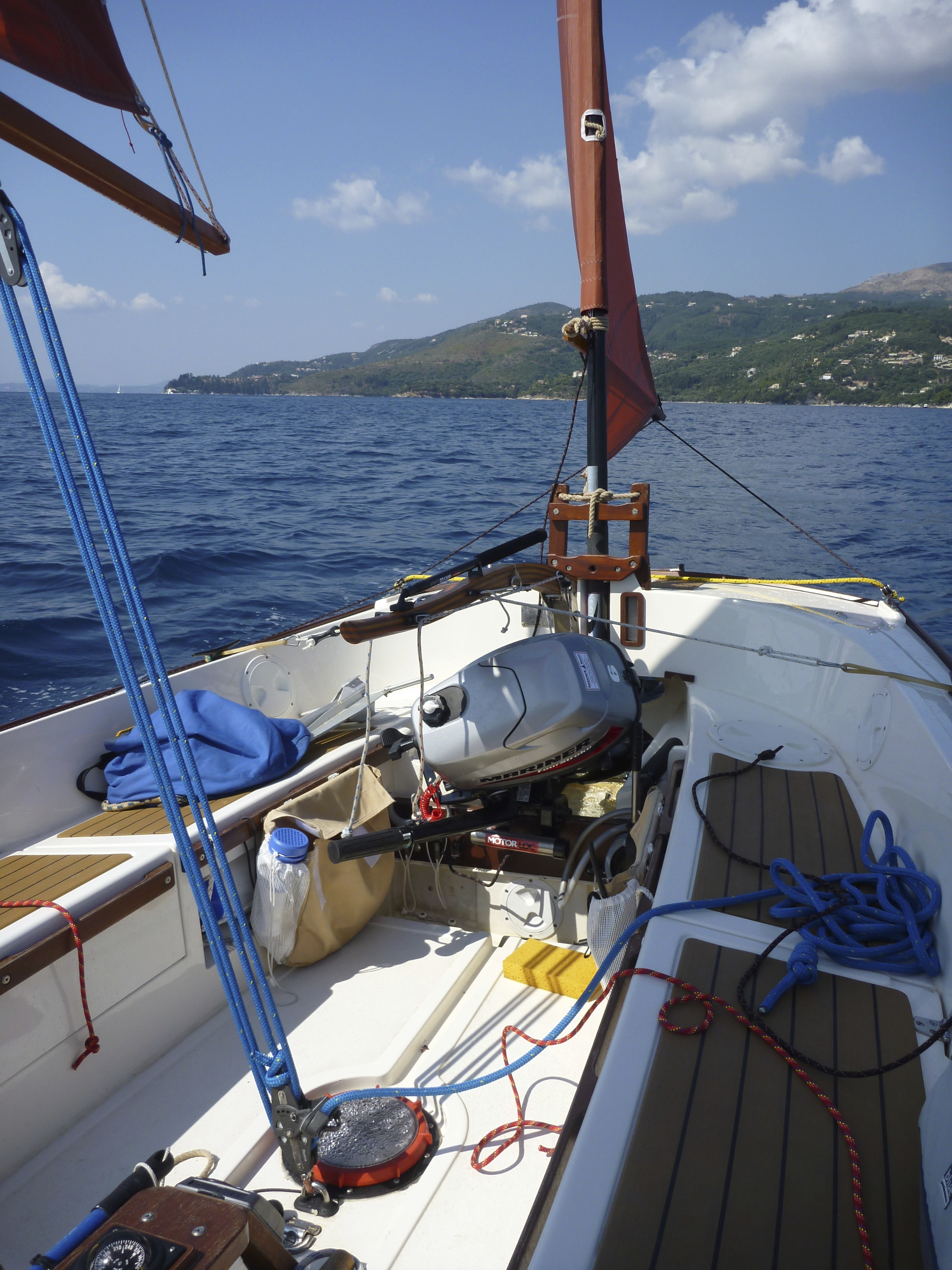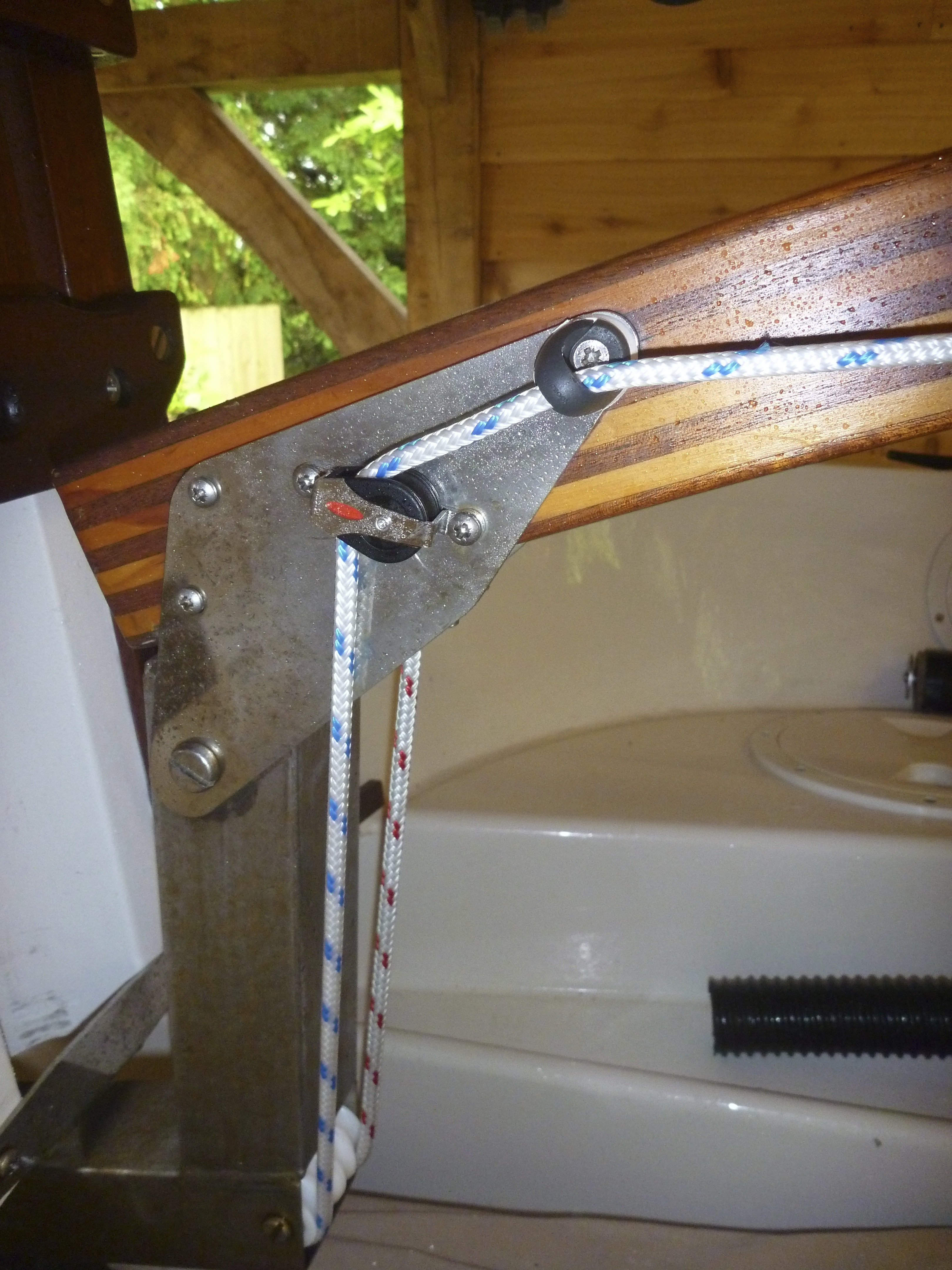With one or two exceptions SwallowBoats has always predominately produced sailing boats, however they also recognised that secondary methods of propulsion are very useful. To this end, many boats can be rowed, used with an outboard or both. Furthermore, the use of an outboard is not an afterthought, with the motor hanging off the transom, and most boats have inboard wells where the motor can be positioned at close reach for the helmsman and on some boats a clever arrangement places the motor immediately forward of the rudder. Given that almost all SwallowBoats’s craft have an outboard attached the only question is which outboard should owners choose?
BayRaiders
All BayRaiders have an outboard well immediately forward of the rudder. This places the outboard exactly where it is required by the helmsman and also means the water from the prop is pushed on to the rudder, resulting in excellent steering using the rudder when the outboard is used. The outboard well is shaped to allow outboards to be tilted up and a series of plastic “lamellae” close over the well when the outboard is lifted, creating a smoother hull with less drag and reduced noise from the well.
The lamellae mean that for an outboard to rotate through 360°, which is required for outboards without reverse gear, the outboard’s leg must not have have an elongated cross section. A narrow leg is best and the Honda 2.3hp and Suzuki 2.5hp 4 stroke outboards both have these and rotate without any issues. Any other outboard without reverse gear should be carefully checked to ensure it will rotate. If the outboard cannot rotate then an outboard with reverse gear must be used.
A standard/short shaft outboard is required with a power of between 2hp and 6hp depending on the conditions likely to be encountered when motoring. The small Honda and Suzuki 4 strokes mentioned above will push a BayRaider at over 4 knots in normal conditions.
Where sailors are likely to have to push against strong tides, waves or wind a larger engine of 4hp to 6hp should be used. It should also be remembered that the BayRaider Expedition’s one piece carbon mast is taller than the BayRaider’s and more affected by strong winds, so may require a more powerful outboard to compensate if it will be regularly used in such conditions. A 6hp motor with a high thrust propeller will push a BayRaider 20 at 6.5 knots, more than its theoretical hull speed, creating a large wake in the process. There is no need to use a larger outboard than this as all it will do is add further weight at the stern.
Small 4 stroke outboards and all 2 stroke outboards will fit in BayRaiders without any adjustments being required. The Suzuki 2.5hp 4 stroke outboard tilts until it is almost horizontal and that can cause the outboard’s leg to hit the rudder at full tilt. However, the tilt pivot on this outboard is often stiff enough that the engine can safely be left tilted partially such that it is clear of the lamellae while not fouling the rudder. Alternatively, wooden wedges can be fitted behind the engine clamp as described below. This issue does not occur with the Honda 2.3hp.
If choosing between a Honda 2.3hp and a Suzuki 2.5hp, there are other issues to be aware of. In addition to having no reverse gear, neither engine can fit an external fuel tank, which means that you only have about an hour’s cruising with the integral fuel tank before having to fill it up again. The Honda has a centrifugal clutch which takes a bit of getting used to – the gears will only engage when the throttle is opened. The Suzuki has a standard forward/neutral gear lever. The Honda is air cooled, which ought to make the cooling system more reliable. The Suzuki is water-cooled and in addition to potential cooling system blockages, the water pump impeller has been known to fail. Lastly and possibly the most off-putting, the Suzuki carburetor is known to suffer from a flat spot just past minimum revs which can cause the engine to stall when the throttle is opened. This is allegedly caused by the need to comply with EU anti-emission regulations which restrict fuel flow until the engine is warm, although it also happens when the engine is warm. Again allegedly, this problem can be solved by having someone who knows what they are doing (which does not necessarily include Suzuki service agents) exposing the carburetor adjustment screw, which is blocked off with a metal plug to prevent you from making adjustments.
Many of the 4 stroke outboards in the 4hp to 6hp range are identical in size and weight – they only differ in their tuning (and price) to produce different power outputs. They will all fit in a BayRaider but minor modifications may be required. To fit the engine under the tiller, it may be necessary to elevate the rudder uphaul and downhaul lines by fitting new cheek blocks on the stainless fitting at the base of the tiller. A Ronstan 20mm cheek block fits the existing tiller fixing screws, so there is no need to drill more holes (see photo below – the extra fairlead is optional). If the outboard leg fouls the rudder stock when tilted, wooden wedges should be fitted behind the engine clamp to rotate the motor down and forwards and the trim pin should be adjusted so that the lowered shaft is still at the correct angle when these wedges are in place.

A Mariner 6 shoehorned into a BR20 – when tilted, it needs to be turned to one side to avoid fouling the tiller
In an ideal low carbon world, electric propulsion ought to be the best way to go for the BR20. The problem is, there is still nothing that is really suitable. The lightweight Torqeedo Travel 1003, which is claimed to be equivalent to a petrol outboard of more than 3hp, seems to come closest to the ideal specification but problems include cost (around £1200 plus extras), very limited range at full power, and the overall dimensions.
The Torqeedo’s standard short shaft length is 62.5cm, compared to an outboard industry norm of 40-50cm. The extra shaft length means that the motor cannot be tilted up into the engine well as the skeg fouls the back of the well. Width is not a problem on the 1003 because the long bladed propeller only has two blades but the latter cause the problem with the shaft length. Torqeedo had to lengthen the shaft so that waterline clearance of the top of the long blade is a standard distance. The skeg is similarly lengthened to protect the bottom of the propeller. Suggestions for modifying the motor to fit, and for extending the available range, are given in a separate article in this library.


